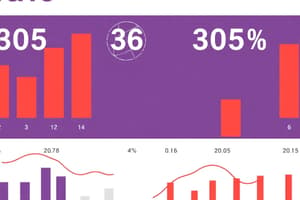Podcast
Questions and Answers
What is the role of inferential statistics in research studies?
What is the role of inferential statistics in research studies?
- To predict the exact outcomes of samples
- To describe the sample data accurately
- To answer questions about the population using sample data (correct)
- To generate general questions about the population
In the context of selecting marbles from jars, what does probability provide a connection between?
In the context of selecting marbles from jars, what does probability provide a connection between?
- Exact and approximate outcomes
- Black and white marbles
- Population sizes
- Samples and populations (correct)
If a jar contains 80 black marbles and 20 white marbles, what is the chance of selecting a white marble?
If a jar contains 80 black marbles and 20 white marbles, what is the chance of selecting a white marble?
- 100%
- 50%
- 20% (correct)
- 80%
How does knowing the makeup of a population help determine specific samples?
How does knowing the makeup of a population help determine specific samples?
What is the primary function of inferential procedures in research studies?
What is the primary function of inferential procedures in research studies?
What is the primary goal of inferential statistics?
What is the primary goal of inferential statistics?
In the two-stage process of inferential statistics, what is involved in the first stage?
In the two-stage process of inferential statistics, what is involved in the first stage?
How does the process of inferential statistics involve using probability?
How does the process of inferential statistics involve using probability?
When selecting a sample of n=4 marbles and all are black, which jar is most likely based on the described scenario?
When selecting a sample of n=4 marbles and all are black, which jar is most likely based on the described scenario?
Why is it crucial to establish probability as a bridge from populations to samples in inferential statistics?
Why is it crucial to establish probability as a bridge from populations to samples in inferential statistics?
Flashcards are hidden until you start studying
Study Notes
Inferential Statistics
- The goal of inferential statistics is to begin with a sample and then answer a general question about the population.
- The process involves a two-stage approach: developing probability as a bridge from populations to samples, and then reversing the probability rules to move from samples to populations.
Reversing Probability Relationships
- The process of reversing the probability relationship can be demonstrated by considering a sample of marbles selected from one of two jars with different populations.
- If a sample of 4 marbles is selected and all are black, it is likely that the sample came from jar 2, which has a high proportion of black marbles.
Using Samples to Make Inferences
- Inferential statistics uses the sample data to make inferences about the population.
- Research studies begin with a general question about an entire population, but the actual research is conducted using a sample.
- Inferential procedures are built around the concept of probability, which defines the relationships between samples and populations.
Probability and Population
- The probability of obtaining specific samples can be determined by knowing the makeup of a population.
- For example, in a jar with 50 black and 50 white marbles, the probability of selecting a black marble is 50%.
- In a jar with 90 black and 10 white marbles, the probability of selecting a black marble is higher.
Studying That Suits You
Use AI to generate personalized quizzes and flashcards to suit your learning preferences.




